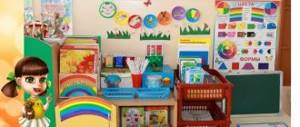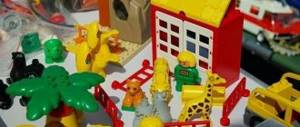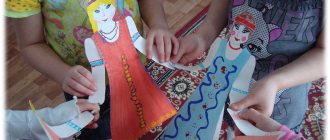Game as a means and way of teaching preschoolers article on the topic
Teacher of GBDOU kindergarten No. 7
Krasnoselsky district of St. Petersburg
Meshcheryakova Evgeniya Yurievna
“Game as a means and way of teaching preschoolers”
It is known that in preschool age the main activity is play; it gives the child maximum joy and pleasure.
Children's play is essential for a child's emotional, physical, intellectual and social development. In preschool age, play is of great importance in the development of children. Play promotes positive socialization of the child. In the game you can improvise, come up with images, situations, thereby learning more and more about the world around you.
Thanks to play in preschool age, mental processes are formed: memory, attention, imagination, speech, etc. The game is not only a means of entertaining preschoolers; it has enormous potential for development and education. But it can manifest these qualities only when it is used within the framework of a controlled pedagogical process. The teacher, guided by the provisions of the kindergarten education program, selects the content of the program and plans it. Children must learn this content through play. The teacher also clearly defines game and didactic tasks, rules, actions and expected results; it is as if he is designing the process of the game, without violating its amateur character and originality. By including play in the pedagogical process, the teacher teaches preschoolers to play, as A. S. Makarenko put it - “to create a good game.” Such a game should have the following qualities:
- the content must have educational and cognitive value, reflect ideas correctly and completely;
- game actions must be creative, organized, active and expedient;
- subordination to the rules of the game, the need to be guided in the game by these rules, taking into account the interests of all players and each individual;
- targeted use of play materials and toys;
- joyful mood of children and goodwill of relationships.
A child’s play activity varies:
— games that develop the necessary social skills;
— educational (didactic) games;
— games that develop speech (speech therapy);
- psychologically oriented games that promote personal and emotional development.
With the help of the teacher creating certain playing conditions, the specialist is able to analyze the behavior of children in various situations and identify various violations in the child’s development. By setting the conditions of the game, the teacher controls certain aspects of the game process and monitors the child’s independent solution to these situations. This approach to children is very gentle and non-traumatic, which makes them ideal for working with children.
Game therapy in preschool age is very relevant, since through play the child expresses all his feelings, emotions, and experiences. It is much easier for a teacher to work with a child, knowing all his weak points. “We learn by playing” is the motto of play therapy!
Thanks to the game, the child receives comprehensive development and forms social and everyday experience for later life.
Children play, devoting themselves to this process with such excitement and passion with which adults do not always devote themselves to their favorite work. Play for children is not only and not so much entertainment, but the fastest and most effective way to learn to interact with other people. That's why they take the game very seriously. And we, adults, should also treat children's games with respect. Games help children understand their place in the world and reduce their self-doubt. In play, children create a controlled action space in which they use all their skills. Within the clear framework of the game, they can experiment, build social relationships, try on different roles, attack or defend, take the initiative or transfer it to others, win or lose.
The main structural elements of the game are: game concept, plot or content, game actions, roles, rules that are dictated by the game itself and created by children or proposed by adults. These elements are closely interrelated and define play as a unique activity for children.
During the game, the children themselves (and in some games, adults) establish rules that define and regulate the behavior and relationships of the players. They give games organization and stability, consolidate their content and determine further development, the complication of relationships and relationships. At the same time, the rules of the game help timid, shy children to be active participants in the game.
The task of adults is to create the very environment that will help him develop successfully: to form desires, needs, intellectual qualities in accordance with the child’s age. For a preschooler, the natural, leading activity that determines his further development is play! A game is a kind of school in which a child actively and creatively learns the rules and norms of people’s behavior, their attitude to work, public property, and their relationships. It is a form of activity in which the social behavior of children themselves, their attitude to life, to each other, and personal values is largely formed.
Thus, play is a means of comprehensive education and development of children, as well as a powerful factor in the implementation of an individual approach to the child. The choice of games is essential. Depending on the tasks, games with rules created for children by adults are used. Games with rules include didactic, active, fun games, role-playing games, etc.
At the same time, play also influences the cognitive development of children and causes the need to expand knowledge. The game teaches you to purposefully and consistently reproduce knowledge, to implement it in game actions and rules.
The relationship between play and learning does not remain unchanged throughout preschool childhood. In younger groups, play is the main form of learning. In senior education, especially in preparatory education, the role of the learning process itself in the classroom increases significantly. The prospect of going to school becomes desirable for children. They want to become schoolchildren.
However, the game does not lose its attractiveness for them; only its content and character change. Children are interested in more complex games that require intellectual activity. They are also attracted to sports games that contain an element of competition. In preschool age, play becomes the leading activity, but not because the modern child, as a rule, spends most of his time in games that entertain him; play causes qualitative changes in the child’s psyche. The growing desire for independence and the need to act like an adult leads to the fact that the child strives to imitate adults in everything. It is no longer enough for him to perform only everyday actions. He wants to drive a car, treat people, sell food. But this is impossible to do in real life. The created contradiction between the desired and the possible leads to the emergence of a role-playing game, where the child takes on the role of an adult, performing his functions in make-believe.
The outstanding psychologist A.N. Leontyev emphasized: “...The child’s mastery of a wider, directly inaccessible circle of reality can only be accomplished in play.” The child, modeling the activities of adults in the game, expands the sphere in which he can act. Another famous psychologist, A.V. Zaporozhets wrote: “The game allows you to recreate in an active, visually effective form immeasurably wider spheres of reality, far beyond the limits of the child’s personal practice. In the game, the preschooler, with the help of his movements and actions with toys, actively recreates the work and life of the adults around him, the events of their lives, the relationships between them, etc. Thus, the necessary conditions are created for the child to understand new areas of reality, and at the same time for the development of corresponding abilities.”
Role-playing play is of a social nature and is built on the child’s ever-expanding understanding of the life of adults. A new sphere of reality that a preschooler masters in this game is the motives, meanings of life and activities of adults. The child's behavior in play is mediated by the image of another person. The preschooler takes the point of view of different people and enters into relationships with other players that reflect the real interaction of adults.
D. B. Elkonin, having examined the structure of a role-playing game, showed that its central component is a role - a way of behavior of people in various situations that corresponds to accepted social norms and rules.
Fulfilling a role puts the child in front of the need to act not as he wants, but as prescribed by the role, obeying social norms and rules of behavior. The preschooler takes the position of another person, and not just one, but different ones. Thus, not only the rules of behavior are revealed to the child, but also their importance for establishing and maintaining positive relationships with other people. The need to follow the rules is realized, i.e. conscious submission to them is formed. Thematic role-playing game allows the child to understand the motives of the work of adults and reveals its social meaning.
In play, the child first discovers the relationships that exist between people in the process of their work, their rights and responsibilities. Responsibilities towards others are what the child feels necessary to fulfill based on the role he has taken on. When playing the role of a buyer, for example, the child learns that he cannot leave without paying for what he has chosen. By performing duties, the child receives rights in relation to persons whose roles are performed by other participants in the game. Thus, the buyer has the right to be given any goods available on the toy counter and to be treated in the same way as other buyers.
The role in a story game is precisely to fulfill the duties that are imposed by the role and to exercise rights in relation to other participants in the game.
Compliance with the rules and the child’s conscious attitude towards them shows how deeply he has mastered the sphere of social reality reflected in the game. The child's attitude towards rules changes throughout preschool age. At first, the baby easily breaks the rules and does not notice when others do this, because he does not understand the meaning of the rules. Then he records the violation of the rules by his comrades and opposes it. He explains the need to follow the rules, relying on the logic of everyday connections: this does not happen. And only then the rules become conscious and open. The child consciously follows the rules, explaining that following them is necessary. This is how he learns to manage his behavior. “The game is a school of morality, but not morality in performance, but morality in action,” wrote D.B. Elkonin.
In play, the child uses a variety of game items: toys, attributes, substitute items. The last group deserves special mention. Substitution arises in a problematic situation: what to do when the doll wants to eat, but there is no spoon? With the help of an adult, the child finds a suitable object - a stick instead of a spoon. True substitution occurs only when the child names a substitute object in accordance with its new function, i.e. gives deliberately new meaning. The main condition is that with the substitute object one can perform the same function as with the one being replaced. Therefore, a spoon can be a stick, a pencil, even a thermometer. But the ball cannot be used instead of a spoon, as it will not scoop up food. The use of substitute objects enriches children's play, expands the possibilities of modeling reality and contributes to the development of the sign-symbolic function of consciousness.
The older the child, the greater independence he shows in the selection and use of substitute objects, the less importance external similarity plays for substitution, and the greater the importance of functional similarity, and the wider the range of objects that he replaces. Attribute objects are of no small importance for the development of gaming activity. They help the child take on a role, plan and develop a plot, and create a play situation. They seem to provide external conditions for the implementation of the role, making it easier for the child to behave in a role. It is easier for a child to perform the role of a doctor when he is in a white coat and cap. In older preschool age, the child needs external attributes less and less, because ideas about the function of adults become such a support.
The game always involves the creation of an imaginary situation, which constitutes its plot and content. The plot is the sphere of reality that is modeled by children in the game. And, therefore, the choice of plot is always based on certain knowledge. That is why, throughout preschool age, “family” games are favorites for children, since they themselves are involved in such relationships every day, and therefore have the most complete understanding of them.
Gradually, preschoolers begin to introduce stories from their favorite fairy tales and films into their games. The games intertwine real and fairy-tale plots, and the reconstructed sphere of reality continues to expand as the child is included in more complex social relations. Everyday stories are joined by professional ones, and then social ones. The richness and variety of plots is closely related to the richness of children's imagination. At the same time, creating game plots stimulates the development of children's imagination and creative activity. Preschool age is a particularly important period in education, since it is the age of initial formation of the child’s personality. At this time, rather complex relationships arise in the child’s communication with peers, which significantly influence the development of his personality. Knowledge of the peculiarities of relationships between children in a kindergarten group and the difficulties they encounter can provide serious assistance to adults when organizing educational work with preschoolers. The relationships of preschool children are formed most effectively when the purposeful pedagogical means is an outdoor game, in which the child masters the rules of relationships with peers, assimilates the morality of the society in which he lives, thus promoting the relationships between children. Preschool children are actively team-building, and it is during this period that great attention must be paid to the development of relationships between them. A successful method of developing relationships is play activity. Children can form meaningful moral ideas about their relationship to each other, unnoticed by them, using outdoor games.
The organization of games must be approached thoughtfully, because their successful management, first of all, involves selecting and thinking through the program content of games, clearly defining tasks, determining the place and role in the holistic educational process, and interaction with other games and forms of education.
The organization of games should be aimed at developing various options for interaction between children and encouraging activity in communication, independence and initiative of children, their use of different ways to solve difficult situations, should ensure friendly relations between participants, and a willingness to come to the aid of comrades.
Project “Game as a condition for the formation of a preschooler’s personality”
Project
“Game as a condition for the formation of a preschooler’s personality”
“A game is a spark that ignites the flame of inquisitiveness and curiosity,” noted V.A. Sukhomlinsky.
Introduction:
One of the main tasks of the modern education system, according to the Federal State Educational Standard for Additional Education, is to reveal the abilities of each child, to educate an individual with creative thinking, ready for life in a high-tech information society, with the ability to use information technology and learn throughout life. Only such an individual can become successful in life. In the context of the implementation of a project in a preschool educational institution, each child independently strives for active activity, and an adult expects a positive, unique creative result from him. Therefore, it is in project activities in preschool educational institutions that it is possible to educate a creative personality with creative thinking, and it is possible to fully develop the cognitive activity of preschool children.
1. Problem
: There are children who do not play and do not like to play. They do not show interest in story-based toys or manipulate them in the same way; their emotional and cognitive activity tone is reduced. Such children have a more difficult time mastering program material, which requires a certain development of thinking and speech, which is largely formed in the game. On the part of some kindergarten teachers, and even more so parents, there is sometimes a tendency to formally teach game actions and plots without taking into account the interests of the children’s personal practical and gaming experience. But in fact this is an important problem. It becomes acutely important in preparation for school, when such qualities as observation, well-formed speech, and a rich vocabulary are important.
2. Goal : to develop interest in various types of games, independence in choosing a game, in implementing what is planned.
3. Objectives of the priority educational area of the project:
“Social and communicative development”:
Help children unite in small groups (2-3 people) based on personal sympathy. Accustom to observe basic rules of behavior during the game. Develop the ability to play together and not quarrel.
Educational objectives in the integration of educational areas:
Cognitive development: Enrich ideas about objects in the immediate environment and support the desire to reflect them in games.
Speech development: Develop the ability to use a friendly, calm tone, speech forms of polite communication with adults and peers, develop speech, attention, memory.
Artistic and aesthetic development: To develop children's interest in participating in educational situations and games of an aesthetic orientation.
Physical development : Develop an interest in outdoor games.
Estimated results of the project:
Knowledge of play areas in the group; The ability to play in a friendly manner, without quarreling; Handle toys with care.
4. Stages and timing of the project:
Project type: And grow. Creative.
Duration: September - May , long-term
Project participants: children of the younger group, music director, parents.
5. Main forms of project implementation:
observations, morning conversations, reading fiction, mini-exhibition “Colors of Autumn”, competition “Dolls in National Costume”, photo exhibition “Mom, Dad, I am a friendly family”, work with parents (consultations, recommendations, conversations, homework) .
6. Expected results of the project:
1) Children reflect developed plots in games. They actively master methods of role-playing behavior, name their role and address peers by the name of the role-playing character, change the intonation of their voice depending on the role.
2) Children have favorite games and roles that they most willingly perform.
3) They understand the game task and act in accordance with it.
4) Show interest in playful communication with peers.
Project products:
1) Attributes for s/r games,
2) A doll in national costume.
3) An entertaining educational board “busy board”.
7. Action plan:
| The content of the work | Predicted result | Deadlines |
| 1. Preparatory stage - conducting a diagnostic examinations | Looking at paintings, illustrations, reading fiction. Parent survey. | September |
| 2. Theoretical preparation for subsequent activities of children | A selection of poems, riddles, games, illustrations on a given topic Conversations: “Why do we need toys? ", “Every toy has its place.” Learning poems from the “Toys” cycle by A. Barto. Fill up the play corners with attributes. Introduce didactic and board games. | October |
| 3.Main stage (See long-term planning by educational area) | Participation in games (didactic, role-playing, board, outdoor, dramatization games.) | October - May |
| 4.Final stage | Photo album “Playing at home and in the garden”; entertaining educational board; doll in Tatar national costume. | May |
| 5. In the future | To develop in children an aesthetic perception of the environment, moral and aesthetic feelings in communicating with peers in games. Lead children to create an expressive image through a dramatization game. |
| Theme , task of the game | Work with children | Working with parents |
| I quarter | ||
| September "Family" Help children unite in small groups (2-3 people) based on personal sympathies. Develop the ability to perform several interrelated actions. | 1. Memorizing “Come and visit.” 2. Reading Kaputikhyan S. “Mom is having lunch.” 3. d/i “Let’s arrange a room for Katya’s doll.” 4. d/i “We’ll make tea.” 5. Conversation about children's family members. Emphasize the family's caring for each other. | 1. Recommendations “Play with your child” 2. Involve in equipping the play area. |
| October Shop "Products" Teach children how to interact in stories with two characters (seller-buyer). Teach to follow the basic rules of behavior in the game. | 1. Examination of illustrations on the topic “Products”, “Fruits and Vegetables”. 2. d/i “We’ll buy vegetables for soup at the store.” 3. Modeling “Apples and pears”. 4.Drawing “Preparing potatoes.” 5. Acting out situations. Conversation between seller and buyer. | 1. Involve parents in making attributes for the game “Gifts of Autumn” |
| November "Visiting the nesting doll" Contribute to enriching children's gaming experience by combining individual actions into a single storyline. While playing, enrich your vocabulary. | 1. d/i “Gifts for Matryoshka”. 2. d/i “Furniture in the house” 3. Acting out the game situation “Matryoshka’s housewarming” 4. d/i “What has changed?” | Consultation “Play with me!” |
| II quarter | ||
| December "Family" Encourage children to try to select attributes for the role. Develop the ability to perform several interrelated actions. | 1. Examination of paintings from the “We Play” series. 2. Reading “The Tsokotukha Fly” by K. Chukovsky. 3. Acting out the situation “Our gifts to Alyonushka.” 4. d/i “Pick up dishes for the doll.” | 1. Memo “Talk to your child” 2.Involve in the making of a doll in a national costume. |
| January "Salon" Introduce the work of a hairdresser. Learn to use substitute objects. Help timid, shy children get involved in the game. | 1. A story about the work of a hairdresser. 2. Fun “Beautiful bows”. 3. d/i “Who needs what for work.” 4.d/i “Who has what dress.” | 1. Involve substitute items in the production: curlers, scissors. 2. Competition “Braid - maiden beauty” |
| February "Kindergarten" Promote the emergence of games on themes from the surrounding life. Develop independence in choosing a game. Promote children's development of role-playing dialogue in the game. | 1. Acting out the situation “We are putting away the toys.” 2. d/i “Every thing has its place.” 3. Conversation “Me and the kindergarten”, “Me and the children”. 4. Entertainment “Our friendly group”. | 1. Recommendations for “Walking with your child” 2. Evening “Fun Gatherings” 3. Consultation “Game as the main form of personality development of a preschooler” |
| III quarter | ||
| March "A toy shop" Diversify the game with play actions (toys have been brought to the store, the seller is laying out the goods). Develop the ability to recognize the properties of objects. | 1. Conversation “My favorite toys.” 2. Modeling “Our toys”. 3. d/i “Find the item according to the description.” | 1. Memo “How to choose toys for your baby” 2. Consultation “The role of toys in children’s games” |
| "Family" Promote the emergence of games on themes from the surrounding life. Learn to maintain role-playing dialogue. | 1. Acting out the situation “Tanya the doll is visiting us.” 2. Communication “Why mom and dad love me.” 3.Reading the German fairy tale “The Pot of Porridge.” | 1. Mobile folder “Mothers and Daughters” 2. Making an entertaining and educational board “busy board” |
| April "Bus" Introduce the profession of a driver. Show the game actions of the “driver” role. Facilitate grouping into small groups (2-3 people). Develop the ability to interact with each other. | 1. Memorizing “The Driver’s Song.” 2. d/i "Transport". 3. Application “Bus”. 4. p/i “Birds and cars”. | 1. Involve in the production of attributes |
| April "Hospital" Enrich children's gaming experience by combining individual actions into a single storyline. Develop the ability to independently select attributes and choose a role. | 1. Listening to “The doll is sick.” 2. Modeling “Let’s help Doctor Aibolit cure children.” 3. d/i “Who needs what for work?” | 1. Making substitute items: thermometers, pills. |
| May "Zoo" Learn to use building materials in the game. Develop the ability to play a role for yourself and for a toy. Improve your ability to interact with each other. | 1. Conversation about wild animals “Who lives in the forest?” 2. Construction “Let’s build a fence for the animals.” 3. Theater show on flannelograph “The Fox and the Hare”. 4. d/i “Whose children?” | 1. Exhibition. Joint drawing of parents and children “Unusual Animal”. |
8. Conclusions:
The result of my work was the positive dynamics of children’s play activities. The use of non-traditional gaming methods and techniques with preschoolers made it possible to achieve high, stable results and achieve the goals set. Children have become active and sociable in communicating with peers, acquaintances and strangers in various communication situations. We learned to agree on the theme of the game, agree on the sequence of joint actions, establish and regulate contacts in a joint game. Preschool children began to show more creative independence in play.
Parents began to pay more attention to games with their children. As a result of joint play activities, children learned to transfer play actions from one toy to another. She widely used demonstration games in her work. We can safely state that: - the level of speech development and speech etiquette has increased; - children have acquired the ability to control their emotional state; — conscious behavior and communication in society appeared. — emotional contact with the families of pupils has increased.
1.1. Games relevant for the development of the personality of a preschooler.
Elements of role-playing play begin to develop in early childhood. In preschool age, play develops into a specific activity that has a complex structure. For a preschooler, play is the leading activity that causes qualitative changes in his psyche (which were mentioned above). Play is also important for a child’s acquisition of social communication skills and interaction with peers, not to mention the fact that in the process of play activity the child penetrates into the world of adults. Thus, human play is an activity in which social relationships between people are recreated outside the conditions of directly utilitarian activity.(14)
There is such a variety of games for preschoolers that it is necessary to structure our knowledge, otherwise confusion will arise.
The most relevant for preschoolers are role-playing, didactic and outdoor games.
We begin our review with role-playing games. Role-playing games
have the following structural components:
Plot
- that is, the reality that children reflect in their games. Usually they reproduce scenes from family life and work. At the same time, each preschool age tends to reproduce different aspects of reality within the same plot (from focusing on performing an action to reflecting complex social relationships).
Content
- the moment that the child highlights as the main one in the activities of adults.
Throughout preschool childhood, both the plot and content of the game become more complex.
During role-playing games, the preschooler takes on certain roles
and obeys
the rules
, demanding that other children follow them. Considering this feature of role-playing games, it is important for an adult to competently guide children’s play in order to convey to them the moral standards of behavior and rules that are reproduced by children during play activities.
Didactic games
- This is a specific and meaningful activity for children.
This type of game has ready-made game material, design and rules
, i.e. didactic games are used in the pedagogical process (in contrast to role-playing games, which are spontaneous).
Didactic games have a goal
, i.e. this game is aimed at obtaining a specific result. The goal has two aspects:
- cognitive, i.e. what we should teach the child; educational, i.e. those methods of cooperation, forms of communication and attitudes towards other people that should be instilled in children.
The purpose of the didactic game is aimed at developing certain mental processes and abilities. In the case of our research, the goal is to develop empathy, politeness, and sensitivity. The game plan is a game situation into which the child is introduced and which he perceives as his own. In all cases, the intent of the game is realized in game actions
, which are offered to the child in order for the game to take place.
An important feature of the game are the game rules
, which convey to the children’s consciousness its intention, game actions and educational task.
An adult organizes the game and directs it - he helps to overcome difficulties and evaluates the child’s actions.
Didactic games are meaningful activities for the child, in which he willingly participates. The social experience gained becomes his personal property, since it can be applied in other conditions.
The game should give the child the opportunity to put into practice what is familiar to him and encourage him to learn new things. Among the educational games we can highlight:
(“3”) games aimed at developing humane, moral relations, volitional qualities of the individual, which are expressed in actions and actions. (Chapter 2) games that promote sensory development (auditory perception, perception of color, shape, qualities, size). They are relevant for younger preschoolers, when the child does not yet identify and recognize the distinctive qualities of surrounding objects. While playing, the child learns visual, auditory, and tactile examination techniques that help to distinguish and highlight the qualities of objects, compare them based on these qualities and designate them with the appropriate word, i.e., he develops sensory standards that are the basis for a full perception of the surrounding reality. games that develop cognitive processes (intelligence, memory, attention, speech).
Each didactic game has two beginnings: one is entertaining, the other is serious. The relationship between these two principles determines the type of game.(1)
Get full text
Outdoor games
are aimed at improving health, improving the overall physical fitness of children, and satisfying their biological need for movement. A distinctive feature of outdoor games is their emotionality (monotony cannot be allowed). Outdoor games should contain interesting motor tasks, game images, and unexpected situations. There are outdoor games aimed at developing dexterity, coordination, speed, etc.
We bring to your attention another type of game that arouses interest among preschoolers. Perhaps this type of games is not so widely used by children (due to the fact that it requires special intervention from an adult), but their pedagogical value is undeniable.
Theatrical games
– make it possible for a preschooler to get to know the world around him through images, colors, and sounds. Entertainment brings joy, and the fabulousness of the images enhances the attractiveness of the game.
Theatrical games are divided into director's games and dramatization games.
Director's theaters include table theater and shadow theatre. Here the child or adult is not the actor, but creates scenes, plays the role of a toy character - three-dimensional or flat. He acts for him, portrays him with intonation and facial expressions.
By participating in dramatization games, the child, as it were, enters the image, transforms into it, lives its life.
Play as a method of education: what does it teach?
Basics of etiquette. It is quite difficult to explain to a child how to behave properly at the table, because it is much more interesting for him to ride a bicycle. But if you conduct classes in a playful way, then everything will immediately become much more interesting. For example, you and your daughter can sit dolls at the table and teach them to eat properly. At the same time, let the daughter say to the dolls: “Bon appetit”, “Eat carefully”, etc.;- Character. To build character, it is useful to play any competitive games with your child. Play as a means of raising children teaches him to build character, develops self-esteem and confidence. It is natural for a child to want to win. In addition, the role of play in raising children is that children learn to empathize, develop the emotional-volitional sphere, and stimulate activity. In the process of play, as a method of education, situations are created that require immediate decisions, which teach the child to make decisions and take responsibility for his actions;
- Socialization. Play as a means of educating children teaches them to interact with each other and take into account the needs and interests of others. For example, role-playing games help increase vocabulary and develop organizational and creative abilities. Play as a method of education teaches children to develop leadership qualities and reveal their individuality and abilities. And for shy children, play is almost the only opportunity to express themselves;
- Intellectual and moral education of children. The game perfectly contributes to the learning process and development of moral qualities. Thus, it is much easier to teach a child memorization using associations (nine is a circle with a tail, and the letter p is two sticks and a bridge, etc.).
With the right approach, the role of play in raising a child is enormous - it teaches the child to love knowledge, strive for learning and education, and shows the correct models of relationships and behavior. In addition, when learning something through play, the child does not even suspect that he is learning.








